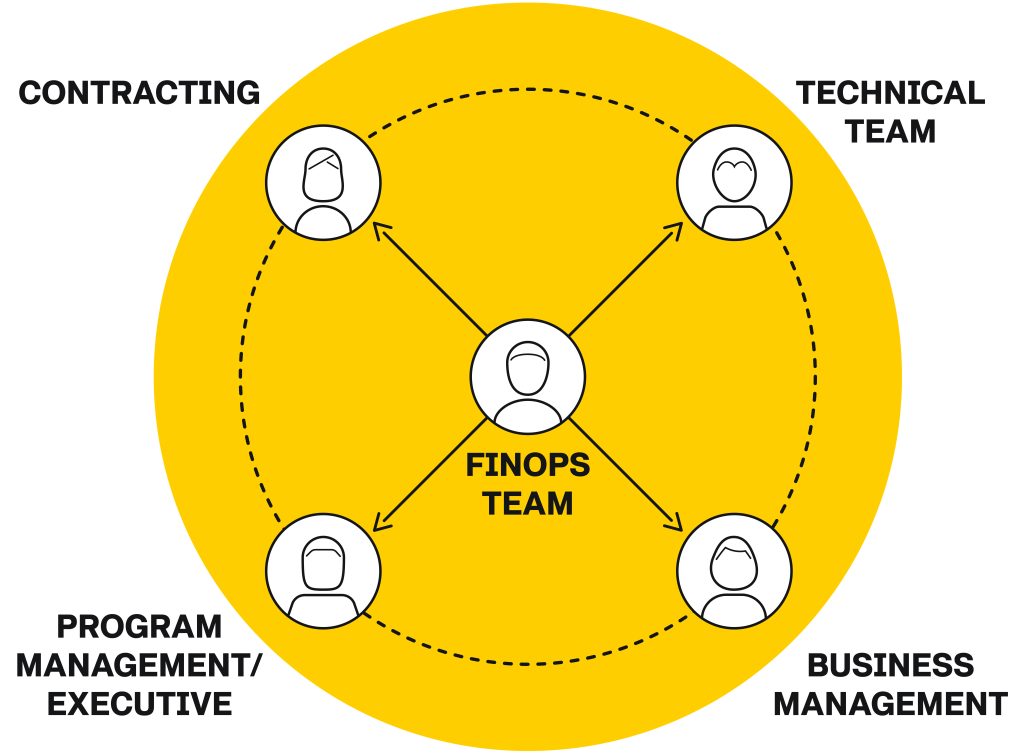
CLOUD STORAGE FACILITY: Digital data is stored on servers at off-site locations, maintained by a third-party provider who is responsible for hosting, managing and securing data stored on its infrastructure. (Photo by Manuel Geissinger, Pexels)
By adopting the financial operations framework, the Army can control and predict costs while maximizing the benefits of cloud computing.
by Robert J. Schadey
In 2018, then-Secretary of the Army Ryan McCarthy made a significant decision to support the migration of the Army’s finance and logistics systems from on-premises data centers to commercial cloud computing facilities. Since then, the cloud revolution has taken firm hold across the service, bolstered by the establishment of the Enterprise Cloud Management Agency in March 2020 and the recent publication of updated guidance within the Army Cloud Plan 2022.
One of the seven strategic objectives of the plan is to provide cloud cost transparency and accountability. To prevent underutilized services and unexpected, avoidable costs, the plan says the Army will use “a combination of enterprise-provided common services and cloud consumption tracking for all cloud consumers.”
One still evolving cloud financial management discipline that’s slowly being adopted by the federal government, including the Army, is financial operations—coined FinOps. FinOps is an evolving cloud financial management discipline and cultural practice that enables organizations to maximize business value and collaborate on data-driven spending decisions, employing cross-functional teams to work together to maintain financial control while also ensuring rapid delivery of capability. The concept of FinOps helps organizations manage their spending on cloud infrastructure and services responsibly. It is a way of tracking and managing variable costs. This makes it easier for program, technical and financial teams to work together and make intelligent choices about the most efficient use of funds.
The U.S. Army Program Executive Office for Enterprise Information Systems (PEO EIS), which migrated the Army’s massive General Fund Enterprise Business System (GFEBS) to the cloud in 2020 and has conducted several more migrations since then, has put a FinOps framework and practice in place over the past two years. Through this framework, the Army is now effectively monitoring and managing cloud infrastructure and services contracts related to cloud computing. This has proven to reduce costs, improve performance and maximize strategic cloud modernization objectives.
To manage the service’s cloud infrastructure budget in years to come, the Army needs the agility and scalability that the FinOps revolution provides.

TEAM PLAYERS: The FinOps team works with cross-functional teams to maintain financial control while also ensuring rapid delivery of capability. (Graphic by the FinOps team, PEO EIS)
EVOLUTION BEFORE REVOLUTION
As cloud computing has become more widespread in both the public and private sectors, organizations have begun looking for ways to leverage cloud services. The goal is to maximize both technological and cost potential. Cloud-based applications enable real-time collaboration among stakeholders, resulting in more efficient operations. Collaboration on cloud infrastructure and services can be accomplished through the built-in tools of cloud infrastructure service providers. These applications give users visibility into their cloud infrastructure to track, manage and optimize their cloud costs.
At a higher level, organizations need to implement cloud-based contract vehicles, such as the Army’s Cloud Account Management and Optimization (CAMO) or DOD’s Joint Warfighting Cloud Capability and financial management solutions, to maximize the benefits of cloud computing. FinOps has become a framework for organizations to better manage cloud infrastructure and service costs.
FinOps aligns cloud computing business objectives—such as increasing organizational agility and improving customer experience—with financial goals like reducing capital expenditures and optimizing operational costs. It is a method that helps organizations save money on cloud infrastructure services by promoting collaboration and finding ways to innovate more efficiently.
FinOps brings together people from different departments to work on cost-cutting decisions. It breaks down organizational silos and the traditional budgeting process to make the process more efficient. By leveraging collaboration and continuous improvement for efficiency and innovation, FinOps helps organizations optimize the cost of cloud infrastructure services and manage the entire economic cycle of cloud computing.
To address the complexities of the cloud computing landscape, FinOps methods and tools are continually evolving. While some organizations have their own FinOps teams, others use third-party vendor services and tools to help with cloud financial management.

CONTINUOUS MONITORING: By using FinOps to continuously monitor cloud expenses, PEO EIS has maximized the value of cloud infrastructure resources and services for the Army. (Graphic by the FinOps team, PEO EIS)
FINOPS FORECASTS
FinOps helps organizations better forecast their cloud spending and plan for future investments by delivering a unified view of all cloud costs across services, accounts and resources. It provides visibility into usage trends, cost trends and budget forecasts, allowing organizations to track their spending and adjust their budgets accordingly. FinOps can provide actionable insights and optimization recommendations to help organizations identify areas for cost savings and better manage their cloud investments. For example, a FinOps team may determine that services are over-provisioned on a specific type of compute resource and recommend scaling back the number of resources used to save costs.
Among FinOps’ key benefits are improved utilization of the cloud’s resources—including compute power, memory and network—and reduction of costs traditionally associated with dedicated hardware in legacy IT environments. FinOps also:
- Enables better-informed decision-making to reduce waste associated with inefficient resource purchases.
- Provides better visibility of cost and utilization of resources across all departments, allowing for easier management and optimization.
- Offers increased ability to adapt quickly through faster deployment times.
- Increases transparency and accountability with detailed metrics collection.
- Ensures improved communication among departments.
- Features assessment process automation for faster settlement timelines.
- Provides real-time insights powered by artificial intelligence algorithms.
FinOps’ key performance indicators offer empirical proof, boosting compliance levels.

THE FUTURE OF FINANCIAL MANAGEMENT: Financial operations are no longer handled the old-fashioned way. The federal government, including the Army, is slowly adopting FinOps—an evolving cloud financial management discipline that helps organizations manage their spending on cloud infrastructure and service responsibly. (Photo by Tima Miroshnichenko, Pexels)
FINOPS AT PEO EIS
Between 2019 and 2021, PEO EIS successfully migrated its GFEBS, Army Enterprise Systems Integration Program Hub, and Logistics Modernization Program to the cARMY cloud.
After several months of struggling to budget for the variable cloud service costs accurately, PEO EIS team members devoted resources to implementing best practices to improve cloud consumption—specifically via FinOps.
Cloud computing contracts are often easier to manage with the proper tools. PEO EIS put FinOps in place to effectively manage cloud computing contracts by integrating various technologies, processes and best practices. One of the critical components FinOps recommends is leveraging robotic process automation. Leveraging automation in cloud computing helps application owners save time, reduce costs and execute service-based contracts more efficiently.
Another way FinOps has helped PEO EIS manage its cloud contracts is via cost optimization and expense management techniques. The framework enables optimized spending by creating and managing budgets, optimizing resource use, setting up alerts and analyzing cost trends.
By using FinOps to continuously monitor cloud expenses, PEO EIS has maximized the value of cloud infrastructure resources and services for the Army. In fiscal year 2022, the organization avoided $15.3 million in cloud infrastructure costs and achieved $11.3 million in cost savings. The financial benefits were generated by intelligent procurement and optimization actions implemented across the organization on the CAMO contract vehicle.
Leveraging FinOps tools that provide utilization visibility can help organizations calculate the financial risks of storing resources and data in the cloud. In the case of PEO EIS, the FinOps journey is just the start of a revolution in modernizing cost accountability within the Army.
ARMY ADOPTION OF FINOPS
To monitor and manage cloud computing contracts effectively, the Army needs to shift its culture toward FinOps. By adopting this framework, the Army can control and predict costs while maximizing the benefits of cloud computing.
Besides achieving automation and cost optimization, FinOps can help the Army manage cloud contracts through policy management. Army organizations can embed governance rules and guardrails within their cloud contracts, automating compliance, reducing errors and optimizing cloud services. FinOps also offers reporting capabilities that can aid in contract management. Army organizations can review reports on their cloud resources and spending in real time, helping them make more informed decisions when building, modifying and monitoring their cloud services. With FinOps, the Army can ensure its cloud contracts are optimized and compliant, enabling leaders to make more informed decisions and get the most out of their cloud services.
Through cloud FinOps, the Army can improve visibility and control over budgeting and financial management by tracking and managing its IT infrastructure requests for planning, programming, budgeting, and execution (PPBE). This can make the PPBE process more efficient and provide deeper insights into spending patterns to identify areas where budget cuts or adjustments can be made.
By adopting FinOps, the Army can control and predict costs, improve performance and maximize the benefits of cloud computing with the contract structures in place. The Army’s transition to cloud computing through FinOps will modernize how it manages its IT infrastructure while improving responsiveness, transparency and cost efficiency. The Army can rapidly build and deliver applications using multiple funding types and budgetary models. This is done by taking advantage of cloud financial management and the agility and scalability offered by multi-vendor cloud infrastructure services.
The Army’s future budget management will likely become more efficient and cost-effective as cloud computing solutions become prevalent in DOD solutions. Adopting FinOps will enable the Army to understand its spending, track usage and optimize costs by leveraging cloud computing services appropriately. Additionally, cloud computing will enable the Army to use next-generation technologies and services, such as machine learning and artificial intelligence, to automate and streamline financial processes. FinOps will help the Army increase visibility into its financial data, allowing it to better understand the costs associated with its operations and make smarter decisions. Finally, FinOps can help the Army save time and money by automating manual processes and reducing the overhead associated with traditional budget management.
CONCLUSION
By leveraging the power of FinOps, the Army can develop more effective methods for tracking and managing cloud computing-related contracts to reduce costs and improve security. For example, the Department of the Army can use FinOps to strengthen its ability to procure cloud resources, ensure risk assessment and optimize contract management for cloud computing. Properly structured contracts incorporating FinOps accountability will increase cost efficiency and data security. FinOps also can create better metrics for the Army to effectively monitor and manage cloud computing-related contracts, resulting in better budgeting and resource allocation—enabling more funds to be applied toward innovations like artificial intelligence and machine learning.
As the Army continues to scale and operationalize the cARMY cloud in support of Soldiers during a period of fiscal constraint, leaders would do well to embrace the FinOps framework.
For more information on FinOps, go to: www.finops.org.
ROBERT J. SCHADEY is the assistant program executive officer at the Program Executive Office for Enterprise Information Systems at Fort Belvoir, Virginia. He holds an M.S. in computer science and cybersecurity from Capitol Technology University in Laurel, Maryland. He also earned an M.S. in national security and resource strategy from the National Defense University.







